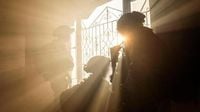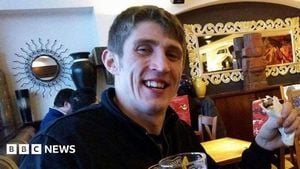On September 26, 2025, a new round of violence erupted across the Middle East as Israeli airstrikes targeted sites in both Gaza and Lebanon, further intensifying regional tensions on the eve of a significant anniversary for Hezbollah. The strikes, which Israeli officials described as necessary to counter mounting threats, came just one day before the one-year anniversary of Hezbollah leader Hassan Nasrallah’s assassination—a date already fraught with emotion and political symbolism for many in Lebanon.
As reported by OneIndia, Israeli warplanes struck east Lebanon on Thursday, September 26, targeting what the military alleged were Hezbollah missile sites. The timing of these strikes was especially notable: hundreds of Lebanese residents gathered at Beirut’s iconic Raouche Rock that evening, projecting Nasrallah’s portrait and the national flag in a dramatic light show that underscored the leader’s enduring influence. With massive crowds expected at Nasrallah’s official burial anniversary the following day, the airstrikes cast a shadow over commemorative events and reignited simmering hostilities between Israel and Hezbollah.
The Lebanese government was quick to respond, condemning the strikes as a violation of existing agreements between the two countries. Lebanese authorities called the attacks an unacceptable breach, echoing a sentiment widely shared among the public. Hezbollah, for its part, asserted that ongoing Israeli operations made any progress on national defense talks impossible. The group’s leadership insisted that dialogue could not continue while Israel maintained a campaign of airstrikes and military pressure.
Meanwhile, the Israeli Defense Forces (IDF) were also engaged in a series of high-stakes operations in Gaza. According to The Times of Israel, IDF troops on September 26 foiled a potentially deadly suicide bombing in Gaza City. Military sources said that units from the 98th Division spotted a suspect wearing an explosive vest near their position and promptly called in an airstrike. The resulting blast triggered secondary explosions, confirming that the man had indeed been carrying explosives. The IDF did not release the identity of the would-be attacker, but the incident highlighted the ongoing danger faced by troops operating in the densely populated and volatile enclave.
Earlier that same day, Israeli warplanes carried out another strike in Lebanon’s Bekaa Valley, targeting what the IDF described as a Hezbollah site for manufacturing precision missiles. Military officials argued that the existence of such a facility violated understandings between Israel and Lebanon, and warned that Israel “will continue to act to remove any threat to the State of Israel.” The airstrikes in the Bekaa Valley were part of a broader pattern of military action along Israel’s northern border, where the IDF’s Northern Command has been conducting regular raids on Hezbollah targets, including operatives and commanders. According to military officials, these strikes now occur roughly every other day, and so far, Hezbollah has not issued a direct military response.
The conflict in Gaza remains just as intense. The IDF’s 98th Division is currently leading Operation Gideon’s Chariots II, a campaign aimed at dismantling Hamas infrastructure both above and below ground. The operation has seen the 36th Division focus on destroying tunnel networks used by militants, while the 162nd Division and 99th Division operate in Gaza City and the northern Gaza Strip, respectively. Over a 24-hour period leading up to September 26, the Israeli air force struck more than 140 targets across Gaza, underscoring the scale and ferocity of the ongoing campaign.
The human cost of the conflict was brought into sharp relief earlier in the week. On September 24, Staff Sgt. Chalachew Shimon Demalash, a 21-year-old soldier from Be’er Sheva serving in the Nahal Brigade’s 932nd Battalion, was killed by a Hamas sniper while on guard duty in Gaza City. According to the IDF, Demalash was critically wounded and later died of his injuries. Troops launched a manhunt for the sniper, but as of the latest reports, the perpetrator had not been captured. The loss of Demalash was deeply felt among his comrades, a stark reminder of the daily risks faced by soldiers on the front lines.
In southern Lebanon, the IDF’s campaign against Hezbollah has also intensified. Last week, Israeli forces carried out broad strikes on weapons depots belonging to Hezbollah’s Radwan Force. Officials stated that civilians were evacuated from the targeted area in advance, a process that took about three hours. The strikes, which reportedly targeted weapons storage and logistical centers, were part of Israel’s ongoing effort to degrade Hezbollah’s military capabilities and prevent the group from acquiring more advanced weaponry.
These military operations unfold against a backdrop of heightened political and social tensions. The anniversary of Nasrallah’s assassination has become a rallying point for Hezbollah supporters and the wider Lebanese public. The massive light show at Raouche Rock was more than just a tribute—it was a statement of defiance and unity in the face of external pressure. As OneIndia noted, the gathering drew hundreds of residents, many of whom expressed outrage at the latest Israeli strikes and voiced support for Hezbollah’s stance on national defense.
The situation remains precarious. While Israeli officials maintain that their actions are necessary to ensure national security, Lebanese leaders argue that repeated violations of sovereignty only serve to inflame hostilities and undermine prospects for peace. Hezbollah’s refusal to engage in defense talks while Israeli operations continue reflects the deep mistrust and entrenched positions on both sides.
For ordinary citizens in Lebanon and Gaza, the cycle of violence has become an all-too-familiar reality. The airstrikes, evacuations, and constant threat of escalation have left many feeling anxious about what the future may hold. As regional powers and international observers watch closely, the hope for de-escalation appears distant, at least for now.
As the official anniversary of Nasrallah’s burial approaches, all eyes are on Beirut and the border regions. The coming days will likely see further demonstrations, heightened security, and, perhaps, additional military action. For now, the events of September 26 serve as a stark reminder of just how fragile the situation remains—and how quickly it can spiral into renewed conflict.




